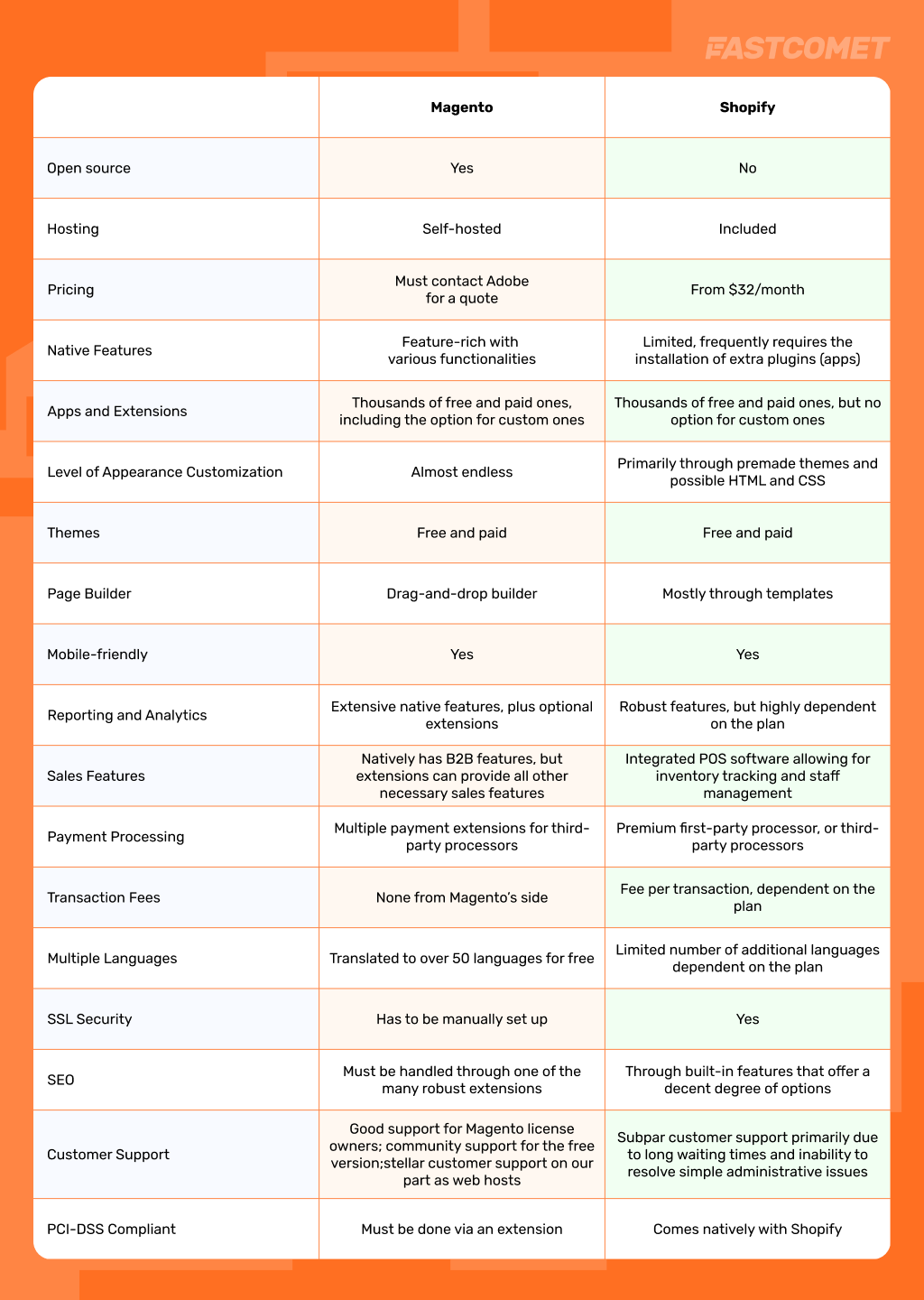In recent years, eCommerce has experienced exponential growth. Based on Statista reports, global eCommerce sales hit $5.8 trillion last year and are projected to reach nearly $8 trillion by 2027. The surge in online shopping is evident, with 2.64 billion online buyers worldwide in 2023, expected to grow to 2.77 billion in the coming years.
Given this upward trend, many are considering launching their online stores. However, choosing the right platform is crucial. In this blog post, we’ll explore two leading eCommerce platforms: Magento (Adobe Commerce) and Shopify. While Shopify is renowned for its user-friendly interface, we’ll delve into situations where Magento shines and why it may be the preferred choice for your eCommerce projects.
Magento and Shopify: Summary
Table of Contents
Before we dive into Magento, let’s first explore what each platform offers in general. Although they are eCommerce platforms aiming to create and manage online stores, they approach this goal differently. Both are excellent solutions, and the significant difference is that Magento is more of a do-it-yourself platform, while Shopify requires much less effort to get a store going. We have compiled the table below to show all their relevant similarities and differences.

As you can see, the table supports what we said earlier: Magento is much more sophisticated than Shopify, but that doesn’t necessarily make it better overall.
While Magento does require you to handle your own domain and hosting services and requires a lot more effort to set up than Shopify, the result is a more feature-rich, extensive, and robust website. A website that can handle a lot more volume, variety, and extensiveness of products than Shopify ever could.
Pros of Shopify
While recognizing Shopify’s strengths, this post doesn’t claim that Magento is definitively better. Both platforms excel in their own ways. Here, we are highlighting Shopify’s strengths and areas where Magento may have limitations.
- Beginner-friendly – Shopify is far better for a beginner than Magento. The developers built the whole platform with ease of use and convenience in mind;
- Affordable – Relatively cheap to start with, Shopify is the better option for customers who want to learn how to build and run a store. Magento, on the other hand, offers a more sophisticated and feature-rich service, but that comes at a higher price;
- Fulfillment – One of the biggest struggles online stores have is getting the bought product from the warehouse (or even having a warehouse) to the customer. Shopify has a network of partners that can do that for you. On the other hand, you have to set up and negotiate everything yourself with Magento;
- Checkout – Shopify’s checkout is far superior to what Magento comes with natively. That is to say, the checkout functionality is near perfect, while Magento doesn’t exactly have one without additional plugins;
- Web Hosting – The fact that Shopify offers hosting alongside their eCommerce platform is a huge advantage. Everything is in one place, and customers love such convenience;
- CMS – On top of the eCommerce platform that Shopify is, it also functions as a complete Content Management System (CMS). It comes with an easy-to-use drag-and-drop website builder, free themes, and the ability to create blog posts for your store;
- No Coding – Users don’t need to know any coding languages to get the most out of Shopify. If you know some it will definitely help;
- Security – Natively, Shopify comes with all the security features a website could ever need: fraud analysis, SSL, and is GDPR compliant.
As you can see, Shopify is great for beginners. Its fantastic features will help you started and keep your online store thriving and growing, but up to a point. That is when Magento comes in: for those professionals who want to take their online store to the next level.
Pros of Magento
Magento’s biggest strength is its sheer scalability and customizability. Shopify is fantastic if you have a small store or are just starting out. It is great, but if their services are proving restrictive or don’t satisfy your store’s needs to function optimally, then it is time to realize it has probably outgrown them.
Scaling
Magento is the answer if your store serves thousands of customers, has even more products than that, and is expected to handle countless daily requests without ever slowing down. We have already talked about how scalable it is, but what exactly makes it that? Why is it so good for these larger stores? The list below will explain everything.
- Modular Design – Magento’s drag-and-drop website builder is not the only modular thing. Adobe created the entire platform with modularity in mind, down to its core architecture. Core functionalities (checkout, product management, customer management, etc.) are separate from customizations and extensions. That way, when a new functionality needs to be added or an old one removed, that can be done by simply installing or uninstalling the necessary module. Since Magento’s architecture is so modular, such actions will not disrupt its core functionalities, affect any of the products or user accounts, or how the website looks;
- Caching – Magento also offers solid caching options in the form of full-page, block, and database query caching. Those reduce the load on the server significantly. Full-page caching generates static HTML for the most visited pages, eliminating the need for the server to do that itself each time a page is queried. Meanwhile, block caching helps further by caching often-used elements on the page. Finally, database caching does a similar thing but for frequently used database queries. As you can see, Magento’s caching capabilities can save a lot of load for the server;
- Optimized Codebase – Magento’s codebase is very optimized. Not only that, each new update from Adobe improves upon it more and more. Most often, these updates fix issues with performance bottlenecks, database queries, and general code clarity and efficiency. On top of all that, Magento is open source, which means the community is also hard at work to make their favorite platform better: identifying problems, submitting their own solutions, creating extensions, etc;
- Database Indexing – Various operations use this to optimize interactions with the database. Things like product attributes, categories, and prices are indexed, thus speeding up search queries. That, in turn, speeds up navigation in general. Additionally, product data is stored in so-called flat catalog tables, which make it easier for queries to navigate them;
- Hardware Scaling – We have already said many times how scalable Magento itself is. Still, it is also fully capable of accepting hardware upgrades as well. For instance, it is entirely possible to have a single store utilizing the resources of multiple servers. That is called horizontal scaling and can help with handling the load the store receives. It is an alternative to vertical scaling, which means literally upgrading the CPU, RAM capacity, or SSD storage of the current server.
Sounds impressive, doesn’t it? These factors are what makes Magento so scalable. However, that is not the only reason it is great for large businesses.
Self-hosted
Since Magento is self-hosted that opens a lot of doors when it comes to the control over the store. While more manageable to set up, Shopify does not allow you free access to the code of your store, to create your own extensions, or even access to the hosting server itself. That is all possible when you are hosting the store yourself. Let’s break it down. We will assume that since Magento is better suited for large stores or enterprises, you already have staff with the required expertise.
- Open source – Most hosting services nowadays offer full access to the files and database their customers are hosting. That makes Magento’s open-source code right at your fingertips to change any way you want. You, or your developer, literally have access to all of the store’s files and database. That means you can easily implement updates or additions, given the appropriate expertise;
- Root-level Access – Because Magento requires some specific software and packages on the hosting server to function correctly, we are assuming the store is hosted on a private server (VPS, Dedicated CPU, etc.). Typically, such servers offer root-level access, which is a huge advantage. It allows for the installation of said software and packages. Not only that, but your system administrators can monitor the server’s performance and provide more complete reports and analytics on how the server itself is doing under the store’s load;
- Store Appearance – Directly a consequence of Magento being open source, and therefore the need for separate hosting services, you dictate how your store looks. While Shopify offers pre-made themes with limited customizability, Magento takes it to the next level. With enough time and effort, you can give your store the precise appearance you want without relying on pre-made themes to dictate how it looks;
- In Charge – The bottom line is that Magento allows you and your team to be entirely in charge of your store. Aside from the host providing you with the server, there is nobody else you need to rely on for functionalities, store options, security, features, or resource usage (to name a few things). Everything is in your hands to run your store how you want. Don’t have a feature? Download it from the Magento store or make it. Want to implement specific security measures for your store? Again, download them or make them, and so on. That level of freedom is a gigantic boon to a thriving business. Just make sure you have people with the necessary expertise handling it.
In November last year, we published a blog post about the differences between WordPress and Django. The crux of that discussion is almost the same as it is here. Convenience versus freedom. WordPress is the more convenient platform but the less flexible one; Django, on the other hand, offers nearly infinite possibilities but requires a lot more effort. We are discussing the same thing about Magento and Shopify here: convenience and ease of use versus flexibility, scalability, and effort.
Conclusion
While Shopify offers convenience and built-in features, its proprietary systems may limit a website’s growth potential. That creates an opportunity for Magento, renowned for its scalability and flexibility, to shine. Ideal for large enterprises, Magento efficiently manages extensive product catalogs and supports multiple stores under one roof. It’s also the go-to choice for B2B enterprises, offering features like complex pricing structures and ERP integrations. Moreover, Magento excels in international commerce with its scalability and language localization capabilities.
On the other hand, Shopify caters well to micro, small, or medium businesses, providing built-in features like first-party POS and a user-friendly website builder. It’s also beneficial for physical stores looking to expand their online presence with integrated blog functionality. Another of Shopify’s strengths lies in its ease of use, making it perfect for non-developers who want to create a store without coding.
Ultimately, the choice between Magento and Shopify depends on your business’s size, growth trajectory, and specific needs. Both platforms deserve recognition for their innovative technology. However, Magento’s limitless scalability and flexibility make it the preferred choice for businesses with ambitious goals. Regardless, the decision rests with the customer, and selecting the right platform is crucial for achieving eCommerce success.






